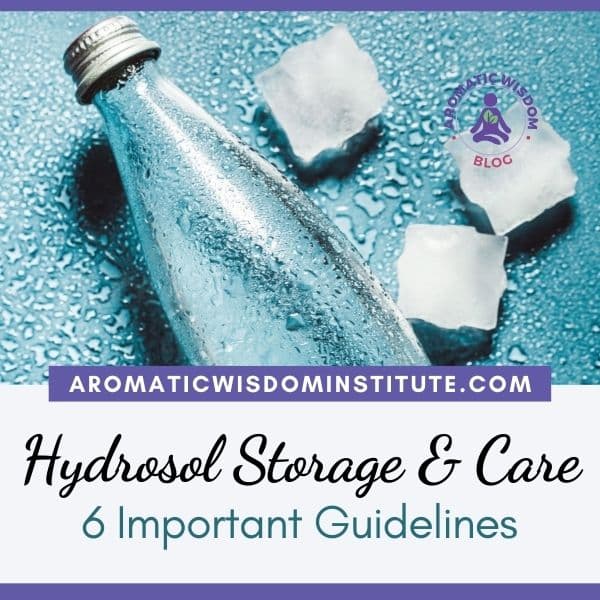If you’re not using aromatic waters called “hydrosols”, I strongly suggest you begin. They are affordable, easy to use, versatile and their therapeutic applications are a safe choice, especially for children and animals. I wrote an earlier blog post called What is a Hydrosol that will give you the basics. In this blog post I’m going to cover the importance of following hydrosol storage guidelines.
Hydrosol Storage Guidelines
Because hydrosols are water-based, they are more fragile than essential oils. In fact, anything that is made of water is subject to contamination and deterioration when improperly stored. Although the shelf life of hydrosols is relatively short – approximately one year – the shelf life can be extended with proper storage and care of your aromatic waters. By the way, never add preservatives or buy them with preservatives added.
Don’t let the delicate nature of hydrosols put you off using them. They offer enormous pleasure and therapeutic benefits; especially you follow the simple guidelines for their storage and handling listed below.
#1 Keep Hydrosols in a Dark, Dry, Cool Location
Direct light, especially sunlight, is damaging to hydrosols. Ideally, they should be stored in a refrigerator. I don’t recommend freezing them as I honestly don’t know the effect this will have on their therapeutic properties. You might consider investing in a small apartment-sized fridge just for your hydrosols and essential oils. If the refrigerator is not an option, then store them in a cool, dark location with consistent temperature like a dry basement. In this case, keep your bottles in a cabinet or box, away from the light.
#2 Store Hydrosols in Clear Glass
Glass bottles are ideal for storing hydrosols and the glass should always be clear, without any color because hydrosol contamination can often be seen with the naked eye (read “Watch for the Bloom” below). Many companies ship hydrosols in plastic or aluminum bottles or even in plastic bags (like the bags used inside a box of wine). This keeps breakage and shipping to a minimum which is understandable. However, if you receive your hydrosols in plastic or aluminum, transfer them immediately into sterilized glass bottles.
#3 Beware of Headspace
When a bottle of hydrosol is partially full, the empty space above the liquid is called headspace. This headspace contains oxygen that, over time, will react with the hydrosol and cause deterioration. To prolong the shelf life of your hydrosol, reduce this headspace. For example, if you have a 16 oz. bottle of Lavender Hydrosol with only 8 ounces left in the bottle, transfer the hydrosol into an 8-ounce clear glass bottle or two 4-ounce bottles. You get the idea.
#4 Keep Everything Sterile
It is easy to contaminate your hydrosol with unseen bacteria from fingers, pipettes, a funnel, an unsterilized bottle during transfer, and even your nose. Don’t let anything come in direct contact with the hydrosol or its bottle. Pour the amount of hydrosol you need into a sterilized container then work with that, rather than risk contaminating the entire bottle. Sterilize everything that comes in contact with your hydrosol sterile with Everclear Grain Alcohol or Vodka. I like to spray the container with Everclear, then let it air dry.
#5 Watch out for the “Bloom”
Sometimes when hydrosols are contaminated they grow a “bloom” (such a lovely word for something so nasty). The bloom can look like a bit of white material or a ghostly blob floating around the bottom. It can also be dark. I mentioned above in “Store in Glass”, although dark bottles are nice for storing your hydrosol, they make it hard to see a hydrosol bloom. You can sometimes hold a colored glass bottle up to the light
#6 Record the Purchase Date
The date of the distillation should be printed or written directly on your bottle of hydrosol. If it arrives without that information, contact your supplier, get the date and write it on the bottle. Indicate the exact month and year of the distillation and the date you received the hydrosol on the label. You can add this to the side of the bottle and on a sticker placed on the cap of the bottle for easy reference.
In conclusion, I love hydrosols and find many many uses for them in my daily life. Again, don’t let their delicate nature put you off trying them. They offer so many benefits, especially if you take care of them using the guidelines in this article.
Would you like to learn more about Hydrosols?
Hydrosols for Health™ is Liz’s comprehensive, step-by-step, online course that will guide you in how to understand and use healing waters called hydrosols.





Great info; obviously an old post as you are referencing an event to occur in 2014.
Hi Lynne! Thanks for stopping by and for your feedback on the blog post. Yep, this one was written in 2014 and I’ve updated the Hydrosol Workshop information to the current dates! Liz
Good article! I’m just getting into hydrosols, they are lovely. I purchased a bottle not too long ago and it had a boom in it. I contacted the company and they sent a new bottle. Is it ok to continue using the hydrosol with the bloom as a room and linen freshener? Thank you!
Hi Cindy, I’m so glad you’re exploring hydrosols – they will add so much to your life! No, please don’t continue to use a hydrosol once you find a bloom in it. Even if you remove the bloom, there is still toxicity in the water. You can water your plants with it, but that’s all. Best to toss and buy fresh. Thanks for writing, Liz
Thank you so much!
Hi there- thanks for this helpful info. I recently made a lavender hydrosol for the first time and after about a month I just noticed a bloom in my spray bottle. It was a 2oz clear glass bottle that has been about half used up. I stored the rest of what I made in a clear glass jar and there is no bloom there. I haven’t put them in the refrigerator. I’m hoping to start producing these for sale, so I obviously need to solve this issue first. Any tips? Thanks! Julia
Hi Julia, I’m so excited for you and your first hydrosol distillation! Beware: It’s addicting 🙂 Good for you that you not only understand what a bloom is, but noticed it in the bottle. That’s why we use clear glass. And never just remove the bloom and keep using the hydrosol. Better to water your plants with it.
The only tips I can offer beyond what you read in this blog post are to keep your supplies, bottles, hands everything SCRUPULOUSLY clean. Remember to sterilize your bottles with 70% Everclear (or Vodka) and 30% water. This slows down the drying time so any bacteria will be killed. You don’t need to refrigerator your hydrosols if you have a room that is dark, cool and constant, like a dry basement or garage.
You’re doing great, Julia. This is all part of the learning process and with time and experience you’ll become an expert distiller and hydrosol artisan! Liz
Hi Liz- Thanks so much for your prompt and thorough reply. I will definitely try again and be much more attentive about sterilization. I really appreciate your help and enthusiastic encouragement. -Julia
Will distilled water cut down on possible blooming?
Hi Kristen, no the type of water used won’t make a difference in the formation of blooms, it is all about keeping everything free of contamination. Liz
I’ve seen blooms in my hydrosols around the plastic tube of the atomizer cap, where as the master bottle has no bloom at all. My only thought is, these caps need to be sterilized before use. Better safe than sorry!
Hi Erica, You’re right, it could be that the caps need to be sterilized with alcohol before closing the bottles, but the contamination could also have come from a pipette that you used to transfer the product or even if you sniffed the bottle and got your nose too close! But you’re probably right about it being the caps. Liz